Reel-to-Reel
4-Track Tape
8-Track Tape
PlayTape
Elcaset
- Decks
- Articles
DCC
Quadraphonics
The Elcaset
Welcome to my page on one of my very favorite audio formats - The Elcaset.
There is not much information on the Web about the Elcaset. So here is
some of the information I have managed to collect on this largely forgotten
format.
The Elcaset was a consumer audio format introduced in 1977 designed to offer both the convenience of the compact cassette and the high sound quality of open-reel tape.
Here are a few pictures of the Elcaset tape itself:
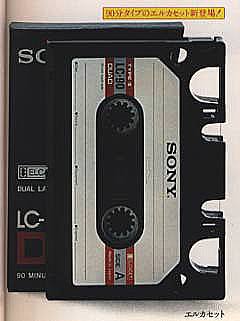
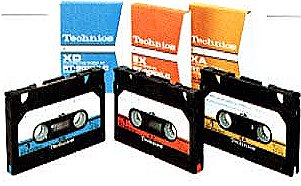
All the blank tapes I have seen are Sony, but apparently some were produced
under the Technics brand name.
The Elcaset was quite a bit larger than the compact cassette. The
picture below is supposed to give you the dimensions of the Elcaset tape, but
it's hard to make out the numbers. The actual dimensions are 152 x 106 x 18 mm
(6 x 4-1/8 x 3/4 inches)

To give some perspective, the Elcaset was about the size of a Betamax video tape
(another failed format championed by Sony).
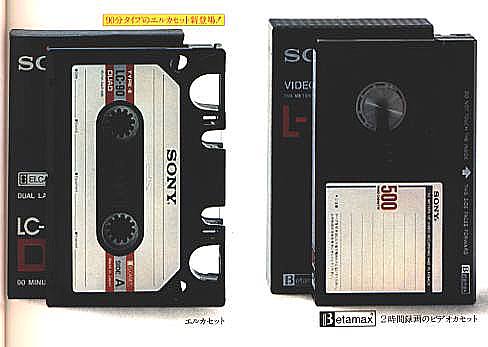
The tape itself was 6.3 mm (1/4 inch) wide and driven at a tape speed of 9.5
cm/s (3 ¾ ips, as opposed to the 1-7/8 ips for the compact cassette). This
resulted in extended frequency and wider dynamic ranges (noticeable in the
higher audio range) than those of the compact cassette. The four-track
tape width in the Elcaset, which was almost twice that of the compact cassette
and nearly equal to the four-track open-reel tapes, also resulted in achieving
the excellent signal-to-noise figures open-reel tapes were able to obtain.
This picture shows the tape used in an Elcaset compared to that of a standard
compact cassette.
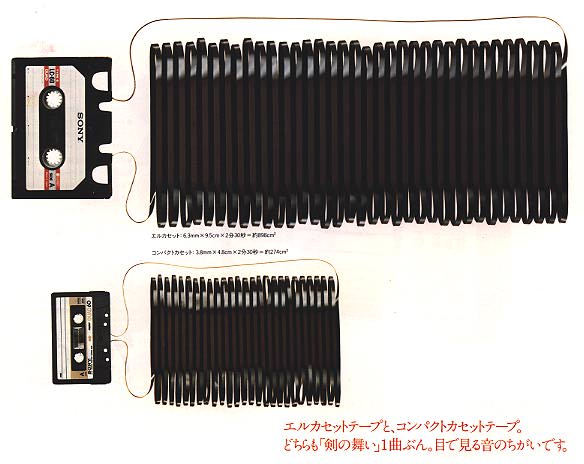
With a conventional compact cassette, the tape was guided by a tape guide pin in
the cassette itself, and the accuracy of tape travel was very much dependant
upon the precision of the cassette shells. This has been an obstacle in
achieving high performance with the compact cassette.
Another problem with the compact cassette is that a multi-head (3-head) system
has been difficult to use successfully since heads of recorders are put into the
very limited space of a cassette. In the Elcaset, tape is in a case, but it is
automatically pulled out by the transport mechanism of the recorder. Therefore,
there is no influence over stability of tape travel by the lack of precision in
cassette shells. As a result, characteristics such as wow and flutter,
modulation noise, cross-talk and level changes are also remarkably improved.
These next pictures show the tape path in the Elcaset.
They show how the tape was actually pulled up outside the shell to come into
contact with the heads. The first picture demonstrates an Elcaset tape
being played on a two head machine (like the Sony EL-5),
while the other pictures demonstrate a three head machine (like the Sony
EL-7).
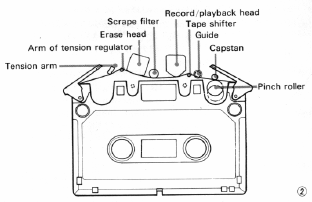
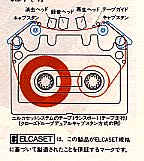
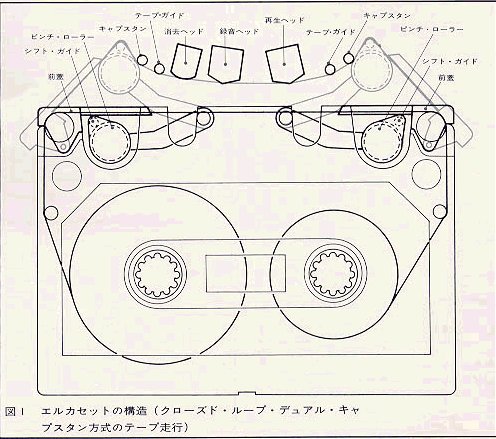
The Elcaset had the same tape format as the compact cassette.
This means the tape was divided into two halves for side A and side B, each side
permitting 2-track stereo or monaural recording and playback. There was
also a pair of "control" tracks running down the middle of the tape,
separating the two tracks of side one from those of side two. Each control track
is less than half the width of an elcaset audio track. The purpose of the
control tracks was never made clear, but there was speculation that they could
have been used for slide synchronization, cueing, or even selection finding in
next-generation decks (unfortunately, the format died before that ever
happened). This picture shows the track pattern on the Elcaset.

Elcaset tapes came 60 and 90 minute lengths. They also came in three
different types: TYPE I had the feature of low noise output (called SLH
tape by Sony). TYPE II had the same performance as FeCr tape by
Sony. TYPE III was the equivalent to CrO2 tape. Elcaset
decks had a tape selector switch which should be set to match the type of tape
used.

The next two pictures show the hole pattern in the Elcaset shell which
indicates the type of tape used.
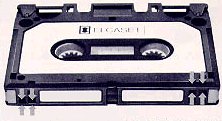
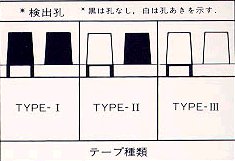
The Elcaset has tape protectors at left and right front ends. When the Elcaset
is out of the tape deck, protectors are closed to protect the tape. Protectors
are opened automatically by the tape deck for threading tape when the Elcaset is
inserted and a function button is depressed. Here is a close-up of the top
of the Elcaset shell which shows the tape protectors.

Nevertheless, the tape runs along the tope of the shell, and it is fairly
exposed. Thus, Elcaset tapes required more careful handling than a
standard compact cassette. This picture shows how an Elcaset tape
was handled and loaded.
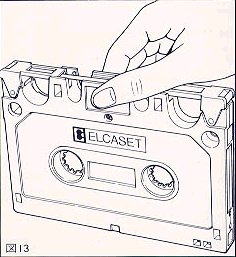
The Elcaset also had reel stoppers which would lock the rotation of a reel hub
to prevent tape from coming loose when the Elcaset is out of the deck. The
stoppers were automatically unlocked by the deck when the Elcaset tape was
loaded.
With the compact cassette, recorded tapes are protected from accidental erasure
by removing a tab on the cassette shell. But once the tab is removed, the
cassette cannot be erased or re-recorded without covering the broken slot. By
contrast, with the Elcaset, the protection is achieved by sliding tabs.
The first picture below indicates where the sliding tabs are located.
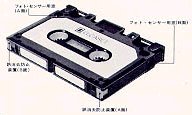

Most Elcaset decks could automatically sense the tape leader that existed at both ends of the tape and thereby initiate an automatic shut off - in both play and record mode.
And finally, the Elcaset decks could automatically sense tapes on which Dolby
noise reduction was used in the recording. This picture shows the location
of the notch indicating whether Dolby was used.
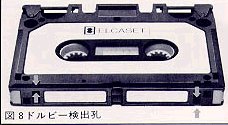
ELCASET specifications
| Tape speed | 9.5 cm/s (3 ¾ ips) |
| Tape width | 6.3 mm (1/4 inch) |
| Time constant | 3180 micro-sec. +70 micro-sec. |
| Reference recording level | 185 nwb/m |
| Types of tape | TYPE I, II, III |
| Dimensions | 152 mm x 106 mm x 18 mm |
Much of the above overview came from the description of the Elcaset format found in the Sony EL-7 owners manual. Click here for the original version of that overview.